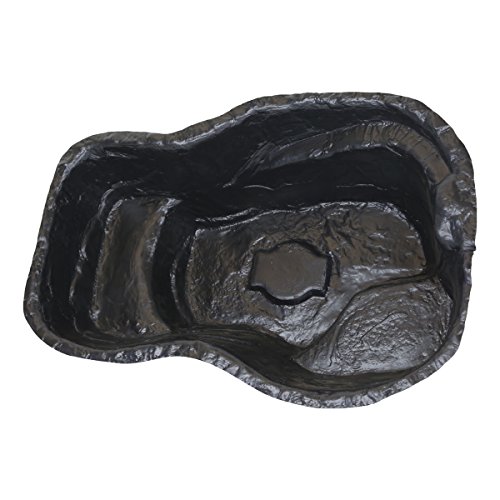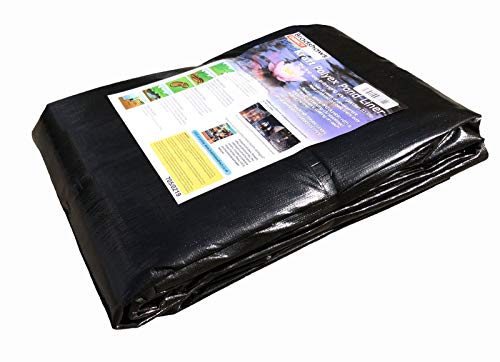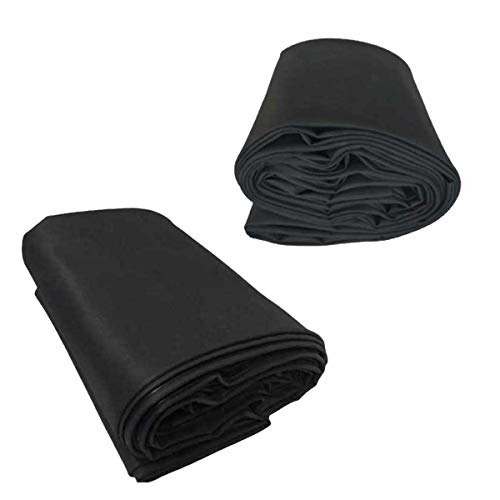Written by Terry Smith
Our site is reader supported so when you click a link to Amazon we may earn an affiliate commission.
UK’s best pond liners: Preformed, HDPE, EPDM, PVC, Butyl
This article was last updated on April 23rd, 2022 at 6:29 am
Building your very own garden pond is a rewarding project but does take a fair bit of time and effort – I’ve personally made and tested several pond liners in my lifetime. If done properly, you’ll be rewarded for all your efforts with a stunning water feature that you can set up some paving or decking nearby, and sit and listen to the running water with your pond filter box while you have your morning cuppa. On the other hand, rushing the job, not following a good plan from the start, and using the wrong materials, can quickly make all your hard work seem like a complete waste of time.
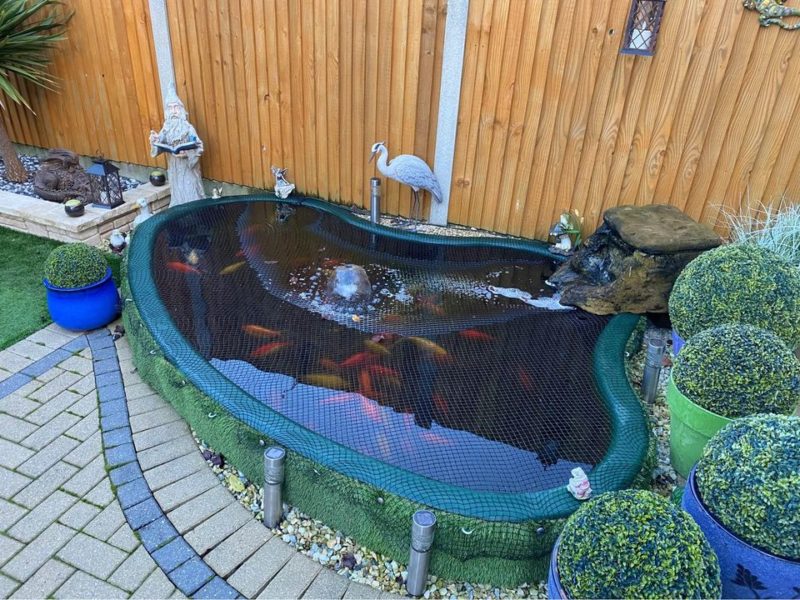
One of the main components of any long-lasting garden pond is a great pond liner. Yes, there are other things you need to make good choices about such as the water pump, but if you install a sub-par pond liner, it won’t be long before you see the water level dropping as it leaks through the liner and into the garden soil.
It can be hard to choose the best pond liners from the thousands of products on sale, especially as they can all look very similar, but if you know the right things to look out for, you can get through that minefield unscathed and get your hands on something that will last you for years.
Our pond liner buyer’s guide below will inform you about what pond liners do, why you need one, and what materials are available to you when you buy your own. On top of that, we have selected the products for our reviews that we think offer the customer the best value for money in their respective sub-categories. Those products are:
Best pond liners: my top picks from years of experience:
Bets pond liner (overall) and Best heavy-duty pond liner– Firestone PondEasy liner
Best preformed pond liner– Bermuda Sand preformed liner
Best budget pond liner– Swell UK pond liner
Best pond liner for koi- PondKraft pond liner
Best pond liner for wildlife- Pisces Epalyn EPDM pond liner
Best alternative budget pond liner– All Pond Solutions pond liner
First though, we thought we’d start by explaining to the uninitiated what a pond liner is and why you need one for your DIY project:
Pond liner buyer’s guide
Here are a few things to contemplate before dipping your hand in your pocket and buying your pond liner. Common sense has probably already made you think of these things, but we thought it wouldn’t hurt to remind everyone.
Pond liner thickness
There are lots of ways your pond liner can spring leaks. Stones and such can poke holes in it, it can over stretch and tear, and just deterioration from UV and cold-weather-enforced cracking can cause problems.
With this in mind, you should probably avoid using any liner that is less than 0.30mm thick, and ideally thicker than that. Common thicknesses to choose from are 0.35mm, 0.50mm, 0.75mm, and 1mm, but most budget products will be at the lower end of that scale. For larger ponds, I advise thicker pond liner and only use 0.30mm for small to medium sized projects.
Sometimes, the thicker pond liners can be less flexible or elastic and harder to install, but there are other variables that come into play like exactly which material the liner is made from, quality, etc. Thicker usually means heavier too which can affect the shipping costs, but on the plus side, the really thick liners might not require underlay, although I would still suggest putting underlay down anyway, just to make sure. A popular brand for pond liner underlay is pondXpert and you should be able to find this stuff easily enough:
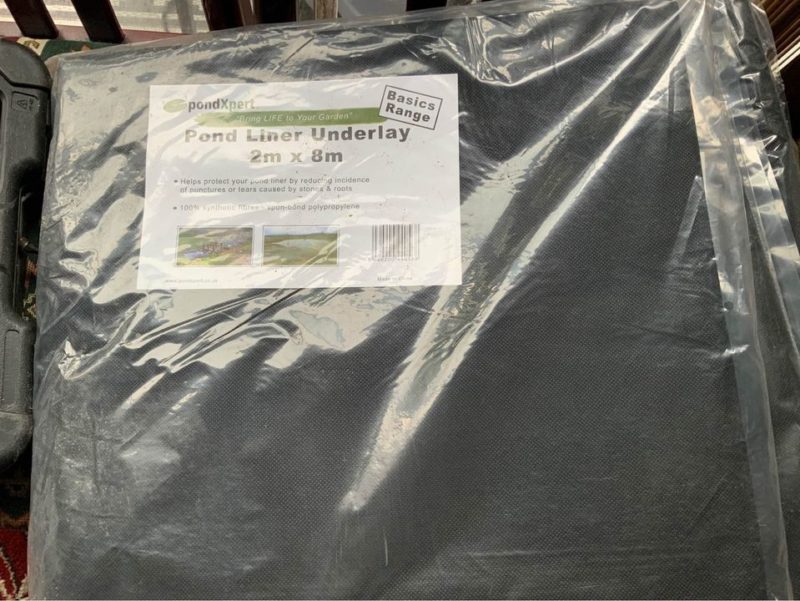
Size
Most flexible pond liners are sold in large sheets, usually in squares or rectangular shapes. Often a product is available to buy in a wide range of sizes, such as 2.5m x 2.5m, 5m x 5m, etc. but some might only sell one size of sheet. The Pisces EPDM liner we feature in our reviews is available in various lengths but only one width of 4 metres.
Preformed pond liners are made from hard plastic and are already a set shape and size which varies from product to product. I’ve seen them from as small as 80cm x 60cm but they do come larger than that- the Bermuda Sand product measures 128cm x 84cm for example.
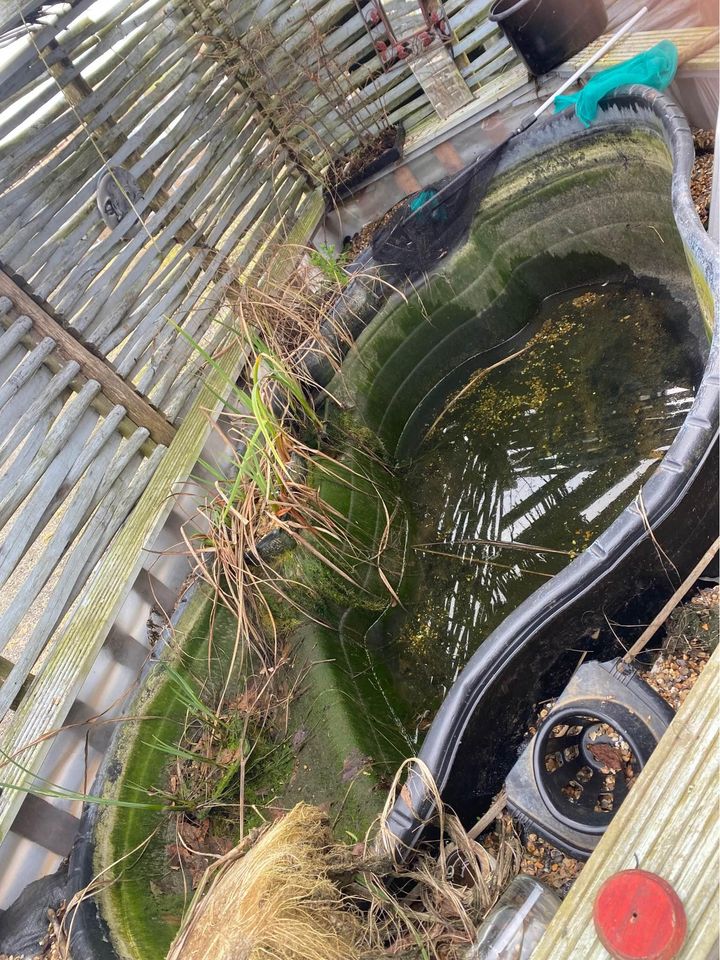
They can save you a lot of time and effort, and are very durable, but you won’t have the option to modify your pond later. Which brings us to our next topic
Modification
We all change our minds as time goes on, and having the option to change the size and shape of our garden pond is a good thing. As we mentioned above, preformed pond liners don’t allow this, but pretty much any flexible material will.
If using PVC liner sheets, you can simply attach them to each other using liner tape. It’s fairly easy, and works surprisingly well. Lining tape can also be used for thicker materials like EDPM, but you also have the option of cutting and heat welding EPDM and Butyl sheets together, and this is what I’d recommend if buying the Firestone EPDM sheets. Obviously, this gives you a more secure seal but it has to be done properly or you’ll damage the sheets and actually reduce the durability of the liner. It’s not difficult though, and I’ve done it plenty of times without any issues. Just watch this clip for an example of it:
What is a pond liner, why do I need one, and which is best for me?
Most pond liners are large sheets that are made out of various materials, such as PVC, HDPE, EPDM, and Butyl. These liners give you a lot of flexibility when it comes to fitting them to the shape of the hole that you’ve dug for your pond, but some materials are stronger than others, which we’ll go into a little later on in this article.
Another type of pond liner that you may come across is the preformed rigid type. Because this type of pond liner is a solid, plastic object (usually made from polyethylene), your pond will have to be made to match that shape and size. On the plus side, they are far less hassle to install and less likely to be punctured by sharp objects like stones. The properties make them an ideal pond liner for first timers. Just check out the excellent Bermuda Sand product in our reviews to see what we mean, or check this photo out-
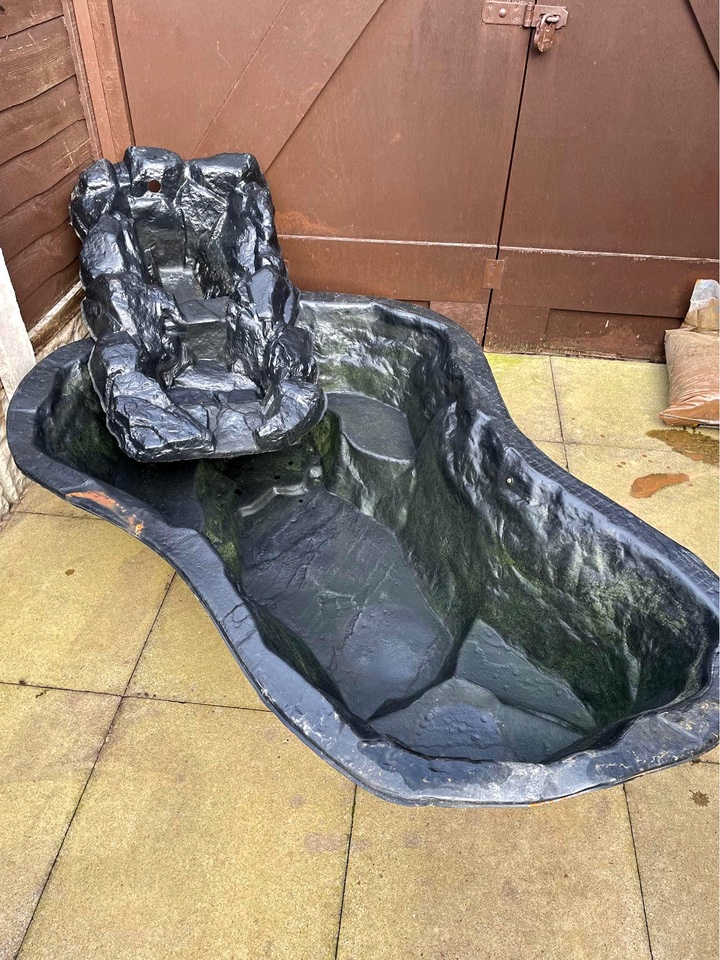
So, why do you need a pond liner (of any kind)? Well, the main and most obvious reason is that you can’t have a pond without water, and no matter what kind of soil makes up your garden, it will not retain water on the surface for long without some help.
Pond liners can also give you a good base on which to layer substrate, and this can be really important for your pond dwelling plants. Some plants will actually do well using the liner itself as a substrate, but I like to add a little something extra to keep the water, plants, and fish, happy and healthy. It would take an entire article of its own to talk about the pros and cons of certain substrates, so I won’t go into great detail here and leave you to do a bit of your own research on the subject.
If you’re confident that you’ll be happy with your pond design for years and years to come, you also have the option of using concrete as your base. Concrete bottomed ponds will not be bothered by the things that can negatively affect plastic or rubber pond liners and are extremely durable – this also counts for water removal which can be controlled with a submersible pump easily – it won’t be affected by an algae cleaner either. The downside is that they are the most expensive and difficult to install properly.
The best flexible pond liner materials- EPDM vs Butyl vs PVC vs HDPE, etc.
There are a number of different materials that pond liners can be made out of, each with its benefits and flaws. In this section, we’ll take a closer look at them and compare them to give you a better all-round view of what’s on offer.
EPDM
EPDM stands for Ethylene propylene diene monomer, bit of a mouthful I’m sure you’ll agree, hence the acronym. Along with Butyl, it is one of the most popular materials when it comes to pool liners for larger ponds due to its flexibility and durability, but I’d say EPDM liners like our best overall pick- the Firestone PondEasy liner , are more popular than Butyl these days.
Being very rubber-like, EPDM can be a great choice for more complicated pond designs with lots of curves and corners as it can be folded as needed. Not only that, but just by using liner tape you can attach pieces to each other, something I found very useful when I decided to increase the size of a garden pond a number of years ago. You can heat bond EPDM sheets, but please be aware that it could damage the quality of the material when you do so if you don’t research how to do it properly.
Sealing EPDM pond liners is another thing you should look into before buying, and so, we have provided this link for you to watch:
Although more costly than plastic liners such as HDPE and LPDE , EPDM is very effective when it comes to holding water where it should, as long as you put down underlay first. This is because although EPDM is heavy and flexible, it can be punctured by sharp objects even though that isn’t as big a risk as with some of the other available materials, such as LDPE. On the plus side, it is resistant to UV and other weather-based damage, and will not harm your fish or plants.
Butyl
Similar to EPDM is Butyl, another pond liner with excellent resistance to UV damage and decent enough protection from cracking in cold weather. In fact, it is hard to find a pond liner material that can handle the temperature extremes at the high end of the thermometer like Butyl can. It is safe for fish, just like EPDM, but unfortunately shares its lack of resistance to chemicals and solvents too.
Butyl isn’t quite as flexible and stretchy as EPDM and some other pond liner materials, but it balances that out with top-notch puncture resistance and longevity. It is one of the materials that truly lives up to the ‘lasts 25 years’ claims made by manufacturers, and I can attest to this as I used it for my brother-in-law’s pond about a decade ago and it’s still going strong.
Lining your pond with Butyl will cost you a bit more than using EPDM or PVC, but the difference isn’t mind blowing, and as long as you don’t mind figuring out how to heat weld the sheets without damaging them too much, you can make it fit pretty much any shape of pond.
PVC
Using PVC pond liners can be a great expense-saving idea, as they tend to be the cheapest type to buy. Not only are they inexpensive, but they are actually better at resisting punctures and tears than EPDM pond liners, although thick EPDM like the Pisces Epalyn EPDM pond liner more than holds its own.
There is quite a variety in sizes and thicknesses to PVC pond liners too, giving you a lot of options. Like EPDM, PVC sheets can be easily fixed together using lining tape and are quite flexible in their own right.
On the other side of the coin, PVC sheets aren’t the best at dealing with weather damage, often cracking and eventually leaking after being exposed to too much direct sunlight or extreme temperature changes- something the UK is well known for and something I found out for myself after lining my very first ever pond with PVC.
Although some people use PVC liners in ponds with fish, I personally avoid them for this purpose as they can contain harmful chemicals, something that you don’t have to worry about with HDPE liners like the Swell product we picked as our best budget offering.. These chemicals are usually in very small amounts and not a threat to you and most wildlife, but for fish they can be deadly. If you’re only having plants in your pond though, they can be a good, low-budget choice.
I have to state here that not all PVC pond liners will still have traces of these chemicals and some are perfectly safe, but knowing which ones actually do or don’t isn’t an easy thing to achieve, and so I just advise being careful.
The following clip compares PVC liners to rubber-like products made from EPDM and shows both types being rolled out and installed:
HDPE
High Density Polyethylene, better known as HDPE, is a fantastic material for lining larger ponds. Although it is thinner and lighter than both EPDM and PVC, it is actually stiffer and this makes it better at resisting tears and punctures.
In addition to offering great puncture and tear protection, HDPE sheets are well known for handling both hot and cold weather conditions, although extremely high temperatures may cause expanding, and are often used for landfills due to the fact that they are not adversely affected by various chemicals.
Unlike PVC, HDPE is safe to use as a liner for fish ponds and is also extremely durable. You will have to pay a premium for all these great qualities, and that might put some first-time pond builders off, but it is a material to keep in mind for a future extension or rebuild.
HDPE isn’t the most flexible choice either, and this might make it a hard material to work with for beginners, especially if you have a complicated pond shape, but more advanced ‘pondeliers’ (yes, I just made that up) might choose it for its durability.
LDPE
So, if HDPE stands for High Density Polyethylene, I’m sure you can guess what LDPE is an acronym for. Yes, that’s right – Low Density Polyethylene.
It probably also won’t surprise you that LDPE isn’t as thick or stiff as HDPE, and therefore is more pliable and better for following the shape of the pond. Less stiffness also means less likelihood of cracking under stress.
On the other hand, LDPE is more easily torn than it’s thicker sibling, and although it is also resistant to UV, cold, and chemicals, it is not quite up to the same levels as HDPE. To end on a high note though- both HDPE and LDPE are safe to use in fish ponds such as with koi and goldfish, as can be seen with the PondKraft liner, and if set up properly and looked after, can last for well over 25 years.
Ok, now that we’ve filled your heads with all the essential information needed to buy the best pond liners, let’s take a peek at the products we picked out as the cream of the crop in the following reviews.
1. Firestone PondEasy EPDM Pond Liner, Vulcanised
When it comes to excellent all-round protection, it is hard to argue against using an EPDM liner, and even the extra you have to fork out will prove worth it when you’re still using the same liner in 10-20 years from now.
It’s because of this, we chose Firestone PondEasy EPDM liner as our best heavy-duty product. Unlike cheaper liners that are made from a thin plastic film, the thick material that this liner is made from has high elasticity combined with its strength, and this makes it perfect for uneven ponds and dealing with movements in the soil over time.
You don’t have to worry about natural occurring damage either. This stuff is resistant to UV radiation, ozone, and both hot and cold weather. What’s more, the absence of antioxidants and plasticisers helps the material to remain intact and fight off premature cracking which can happen with materials of lower quality.
EPDM is completely safe to use for both fish ponds and wildlife ponds as it won’t release any harmful toxins or pollutants into the water like PVC liners. However, if you’re going to be using chemicals, such as algae killers, it could have adverse effects on the material and you might be better off choosing a liner made from HDPE or LDPE which have better tolerance for chemicals.
Other than the susceptibility to certain chemicals, this EPDM pond liner is built to last, and I have no doubts what-so-ever that it will make any buyer very pleased with their decision. If you’d like to get an idea of what installation of this product entails, here’s a clip of someone doing just that. Enjoy:
Pros
- Thick and flexible and won’t tear easily
- High resistance to UV radiation
- Safe for fish and wildlife
- Easy enough to modify
Cons
- Doesn’t deal well with chemicals
2. Bermuda Sand Pre-Formed Pond 128 x 84 cm / Pond Liner
Preformed garden pond liners are a great choice for the less experienced as they eliminate a lot of the frustrations that come with fitting a flexible pond liner for the first time. Basically, all you need to do is get the basic measurements of the liner and then dig the hole. What could be easier?
One of, if not the, best options out there for the money is the Bermuda Sand 128cm x 84cm pond liner, a product that combines durability with some practical design features, and doesn’t cost the earth.
What I like about this preformed pond liner is that it has been molded in a way that gives it a natural feel, rather than the oversized wash basin type that I’ve seen for sale. This shape creates microhabitats that attract wildlife much more so than liners with straight sides.
What is also clever, is that Bermuda has managed to incorporate a pump stand and a wildlife escape into the design too, so you don’t have to worry about any visitors from the animal kingdom getting trapped in there. Trying to make a slope with a flexible liner such as the Firestone EPDM product can be one of the trickier aspects of installation, so it’s good to not have to bother with this one.
Made from high density polyethylene, you don’t have to worry about stones ripping or puncturing holes in this pond liner, and that means you won’t need to put down underlay first either, which will save you time, materials, and money.
Yes, this liner will last you for years to come, but that can also be a drawback because you can’t modify the size or shape of this kind of liner, so you’d better make sure you pick something you’re happy with from the start. The good thing is- I’m pretty sure you will be with this one, just as long as you don’t want a large pond. Don’t get me wrong, as you can see from the photo, it isn’t tiny but not exactly huge either-
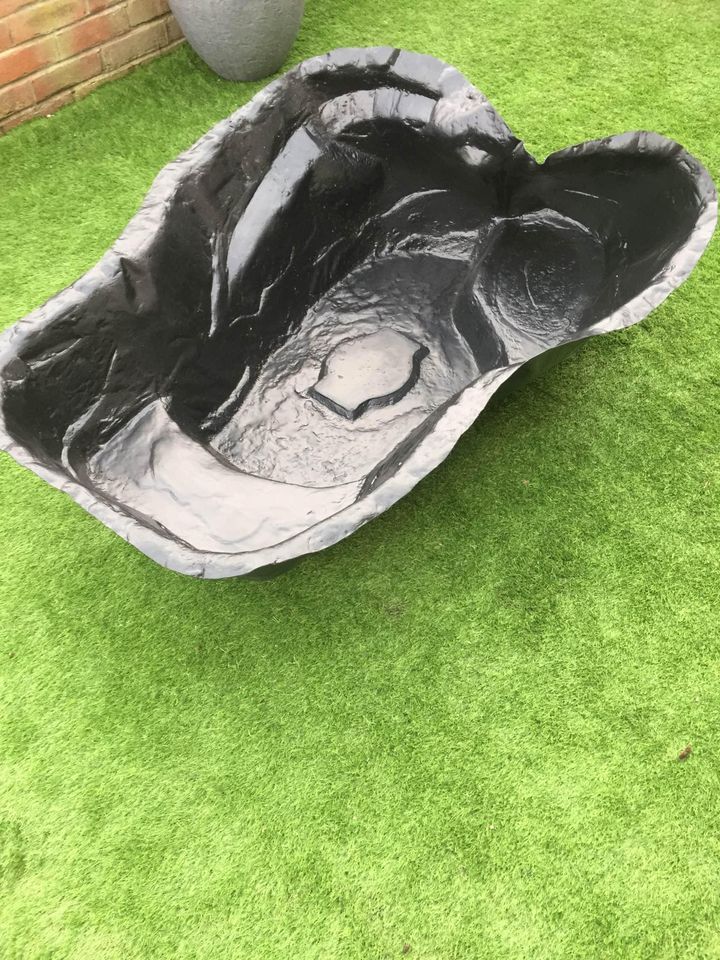
Pros
- Already formed into shape so there’s no stretching and weighing down
- Made from strong polyethylene and very durable
- Easy installation, just measure, dig, and insert the liner
- No underlay needed
Cons
- It’s a set shape and size and can’t be modified later
3. Swell UK Pond Liner 2.5 x 2.5m
I have to be honest and say that I’ve never been a big fan of buying the cheapest pond liners. In my experience, they tend to leak and tear easily and so I wasn’t too hopeful for these low-cost sheets from Swell.
My hopes did rise slightly when I opened the packaging and got my hands on the product though. The material is not some ultra-thin film, but more like a weave made from HDPE, as you can see in the photo we’ve supplied, and at 0.35mm thickness it feels more substantial than I expected. Do I think it is as durable as the Firestone PondEasy EPDM liner or a preformed product like the Bermuda? No, certainly not, but it was better than I thought it would be.
Being HDPE, this liner actually offers very good resilience when it comes to the usual threats of UV and temperature extremes, and won’t be affected by most chemicals, which is something it has over the EPDM liners.
Speaking of chemicals, there haven’t been any toxic ones used in the manufacturing process and this makes these pond liner sheets safe to use for plants, fish, and other wildlife such as frogs.
As this liner is quite thin, it is quite supple and malleable and this makes installation quite easy. I have to point out that there isn’t really any flex though, so bear that in mind before you buy. It shouldn’t really pose a problem as long as you buy enough to keep a bit of play in the liner after it’s installed, but if you leave it pulled a bit tight, don’t be surprised if it tears within a month or so.
This Swell product is available in sheets in a huge range of sizes, all the way up to 30 x 40 metres! I seriously doubt any of you will need quite that much, but it’s good to know that the option for larger sheets is there should you need it. Please be aware that you will need an underlay and that you’ll need to buy that separately, but even then, this liner still offers very good value for money.
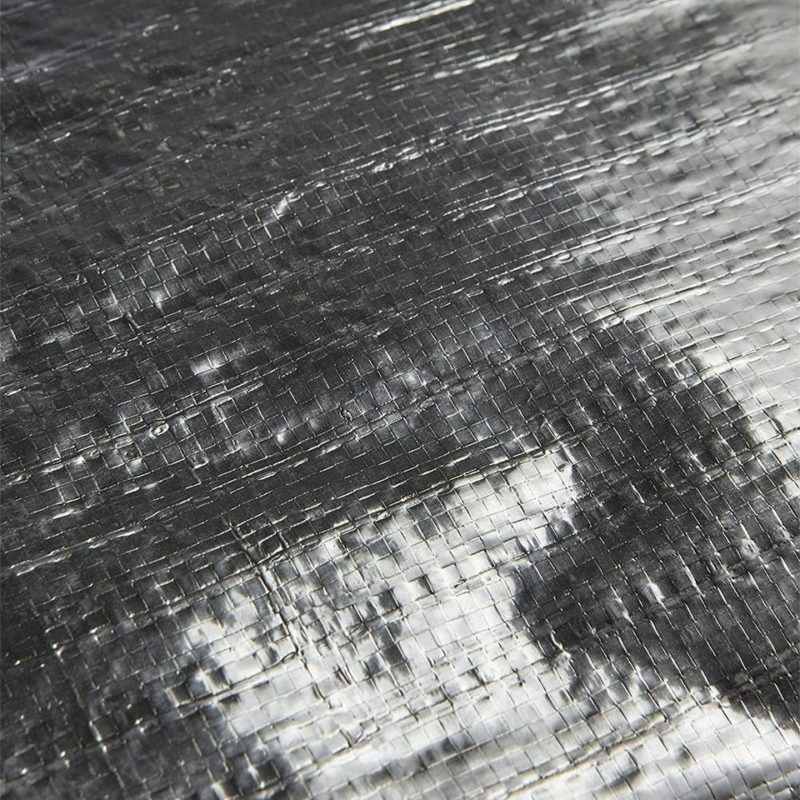
Pros
- Low price tag makes it great for people who don’t want to spend too much
- 0.35mm HDPE material is a good thickness and strength for the price
- Good protection from weather and UV
- Available in a wide range of sizes
Cons
- Not much flex so make sure you think of that before buying
4. PondKraft Pond liner
There’s a lot of conflicting advice out there about which material is best to use as a pond liner for koi. Some will say that EPDM liners are best as they offer very good resistance to UV, while others advise avoiding that material because some of these liners contain harmful chemicals and you have to be careful which products you buy.
This trend pretty much goes on and on about most types of pond liners and it can be a little confusing. Personally, I try not to overthink it too much and choose my koi pond liner based on a few basic things-
First, it needs to be soft and supple as koi are happier in naturally shaped ponds, and that means having a lot of nooks and crannies to get the material around and into. I’ve found that HDPE sheets tend to be a bit stiff for this and so I don’t use them for koi ponds.
Next, the liner will be exposed to a lot of sunlight and must be able to handle the UV and temperature variations. Most pond liner materials are good for this, including EPDM and Butyl, but I prefer LDPE sheets like these from PondKraft because they offer similar protection yet are not damaged by chemicals as easily as EPDM and Butyl.
LDPE is also easy to clean and won’t puncture with a pond vacuum, and as we just stated- you don’t have to worry about using algaecide should you get an infestation of string algae or similar popping up. There are few downsides to using LDPE though, such as a lower tensile strength than HDPE products like the Swell liners, and that could result in lengthwise tears if you’re not careful.
Still, after weighing everything up, including price, ease of installation, and resistance to the elements, I pick these PondKraft 0.35mm liners as best for koi ponds. Yes, you can spend more money on thicker liners, and get them professionally installed, but if you’re making your pond as a DIY project, these are not a bad choice at all, even if the packaging leaves a lot to be desired, as you can see for yourself-
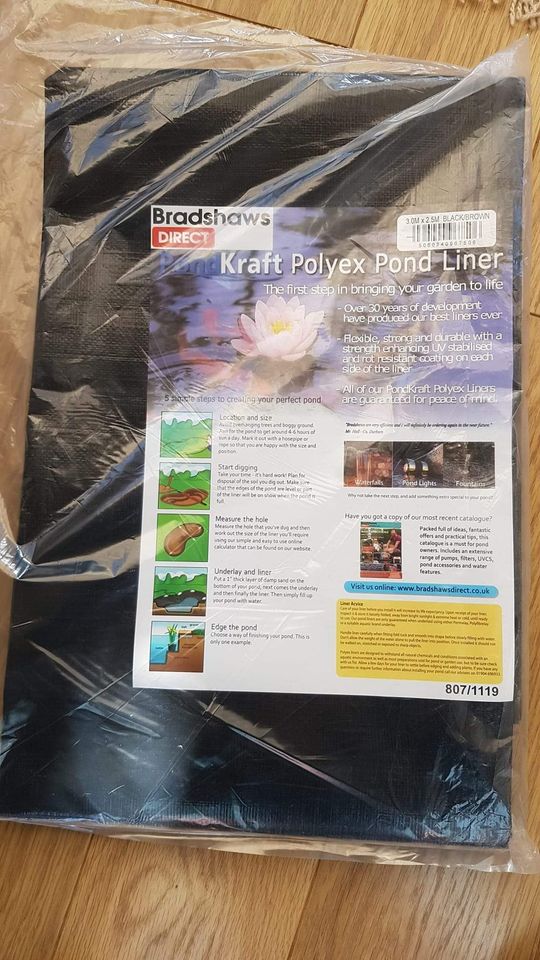
Pros
- Nice and malleable and can be fitted into nooks and crannies easily
- Not damaged by the use of chemicals
- Offers good resistance to UV and temperature changes
- Affordable and should last a long time
Cons
- Not the thickest material out there
5. Pisces EPALYN EPDM RUBBER POND LINER 4m x 1m
Choosing a pond liner for a wildlife pond brings about a new set of challenges on top of the all the usual ones, but we chose this EPDM pond liner from the Pisces brand as our top pick in this category.
Why didn’t I go with LDPE like with our best koi pond liner choice? Well, with wildlife ponds you’re going to get heavier animals such as amphibians and birds coming to visit, and that means more weight and pressure on the edges and sides of your pond. To have the best chance of handling this extra weight, I think EPDM is your best bet.
This product in particular is up to this kind of job. With 0.75mm thickness, you won’t be concerned about tearing if the neighbour’s cat comes around for a nosey peek at the contents of your pond.
You will have to do some heat welding to get this liner in the size and shapes that you require though, as they come in rolls of your chosen length that measure 4m wide. I would definitely say that it’s worth the extra effort, as you are rewarded for it with an extremely durable pond liner that will still be in great shape in 10 years’ time, at least.
Epalyn EPDM is well known for being able to handle everything that nature throws at it, and that includes temperatures down to -40. It won’t crack due to ozone either, and has a high tensile strength and resistance to tearing. Yes, it is more expensive than the PondKraft and Swell pond liners, but it is a much more durable product, in my opinion.
If this is your first attempt at building a wildlife pond, YouTube has plenty of videos showing you how, just like this one:
You don’t have to copy their designs but there are handy tips you can pick up from the odd hours’ worth of viewing.
Pros
- Very thick and strong Epalyn EPDM material
- Not likely to be stretched and torn by visiting birds and other animals
- Can handle extreme cold
- Won’t crack due to ozone like some other products
Cons
- Will need cutting and heat welding into shape
6. All pond solutions Pond Liner
Our final review is of this pond liner from All Pond Solutions, and one that we think is a good alternative to the Swell liner for those on a tighter budget.
It is made from 0.3mm LDPE, but has strength to it that I wasn’t expecting, and I would definitely feel confident about using it for any kind of pond, as long as it didn’t have a ton of curved sections.
I say this because this liner does feel a little stiff for LDPE, and you might have to take your time folding it to fit into tighter areas. I guess this is the price to pay for the strength of the material, and it wouldn’t pose a problem for ponds that are shaped a bit more conservatively.
One little trick I’ve learned over the years with plastic pond liners that are stiff out of the box is to lay them out in the sun, or in a warm room for a while, to soften them up a little. We did the latter with this liner and sure enough it did make things a bit easier when it came to installation.
All Pond Solutions are confident in their product’s durability, and offer a 25-year warranty as long as you install the liner with proper underlay, which you should be doing with all flexible pond liners anyway.
There’s a good selection of sizes to choose from, starting at 2×2 metres and going all the way up to 7×6 metres. As you would expect from a budget pick, the prices remain very reasonable no matter what size you go for.
So, to sum up I’ll just say that this is a decent low-cost pond liner that might require a little warming up to make it more malleable, and would be a suitable budget buy if the Swell pond liner is sold out when you go to buy.
Pros
- Quite thin, but stronger than expected
- UV and weather resistant to a high level
- Good selection of sizes available
- 25 year warranty
Cons
- Not as supple as I would have liked




